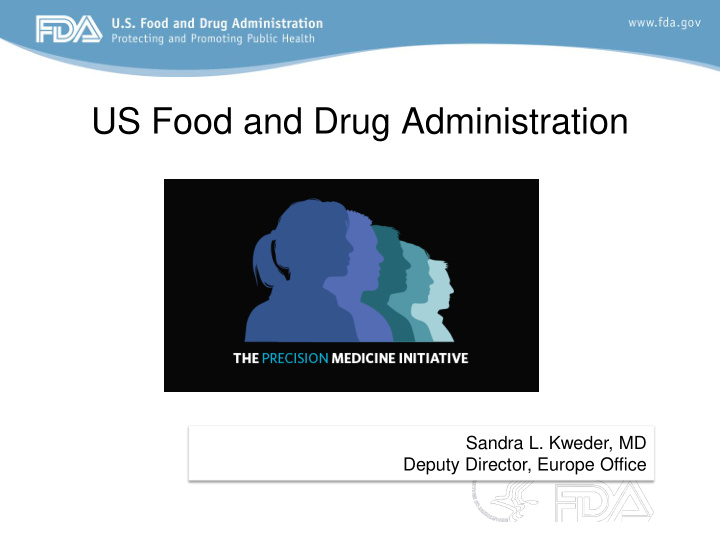



US Food and Drug Administration Sandra L. Kweder, MD Deputy Director, Europe Office
Basics Disclaimer What I will cover today • The views in this • FDA and Precision presentation are my own medicine • I have no commercial • Federal initiative involvement in any of • What we have done so these activities far 2
Traditional approach: One size One Size Fits All Approach • Most medical decisions are based on the “average” patient • What defines an “average” patient? • The more we learn the less clear the definition 3
The Precision Medicine Initiative (PMI) Program to empower patients, researchers, and providers to work together toward development of individualized treatments 4
PMI Objectives • More, better treatments for cancer • Identify more genomic drivers to help develop more effective treatments • Develop 1M person voluntary national research cohort • A patient-powered research effort that leverages existing research and clinical networks • Development of interoperability standards and privacy protections to enable data exchange and sharing • Protect patient privacy
PMI Objectives (continued)) • Regulatory modernization • Streamline regulatory processes for Next Generation Sequencing (NGS) technologies • Enable patient access to their own health information and the software needed for its safe and accurate analysis • Foster public-private partnerships • Develop infrastructure to expand cancer genomics knowledge • Launch the voluntary research cohort
Tailor Health Care to Each Patient The right treatment The right patient The right time 7
Timing is Everything: Build and recycle • Advances in understanding of disease at • Large-scale genome-based research cohorts established across the world • Human-genome sequencing continues to get cheaper and faster • Availability of new data – microbiome, diagnostics, and sensor data • Clinical applications based on genomics and other biomarkers are now available and being used in the care of patients • Every new bit of data adds to the picture, every new test method advances knowledge to build upon 8
What has been done? • Over 23 companion diagnostics cleared or approved • Over 50 biomarkers used in targeting 147 approved drugs – Cystic Fibrosis, Cancer, Cholesterol, Psychiatric, Pulmonary, Infectious Diseases, etc. • Over 56 approved/cleared human molecular tests • More than 24 relevant Guidances issued in past decade 9
Examples of building blocks 10
FDA Guidances: Standards matter • Standards for Next Generation Sequencing (NGS)- based in vitro diagnostic tests (IVD) used to diagnose certain hereditary diseases – How FDA will assess test devices before marketing – We need strong standards, but flexible approaches • Using public genetic databases to support validity of NGS-based IVD – How to make sure data can support rapid marketing approval – How large databases can improve test interpretations and use – The better the information, the more applicable the tests for patient use
Guidance is not enough Modernizing regulation: Next Generation Sequencing testing • New regulatory strategies • How we are doing this for NGS – FDA Workshops – Standards to ensure quality – Open-source tools to help – Partnerships test developers meet – Calls for research standards proposals – Promote translation and innovation by adopting a dynamic regulatory system 12
FDA Sponsors Key Projects: Stanford CERSI * • Scientific training course – Challenges of analyzing genome sequences – Introduce precisionFDA portal – exercises for researchers on portal use to understand best practices and help improve them • Research on ancestry genomics in analysis of diagnostic test methods • Analysis of sequencing technology - consistency and reproducibility *Center for Regulatory Science and Innovation
PrecisionFDA Portal: How it works • FDA sponsors portal for researchers to share • Open platform – Any scientist or research organization can register • Access to data, methods, a way to benchmark, share and improve • Fostering innovation
https://www.youtube.com /watch?v=ir662wQJ5cI
Precision Medicine • We are at the beginning – success is sweet – Individual cancer tissue genomics – Metabolism markers • Next Generation Sequencing (NGS) – Use in diagnostics will launch great strides – Standards in assessment, tool development and validation are critical • Regulators must be engaged at outset – Technology is fast and we must be nimble • FDA is investing and invites anyone to join in
Recommend
More recommend